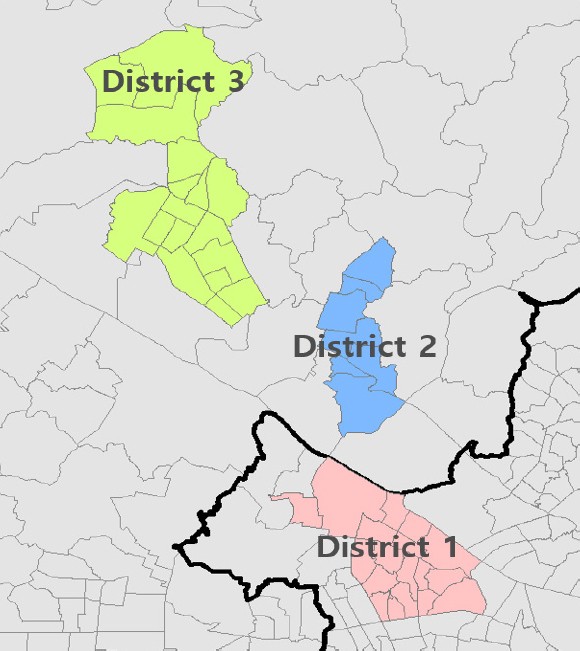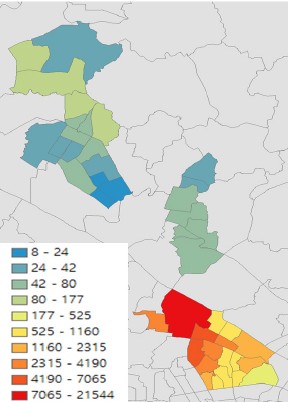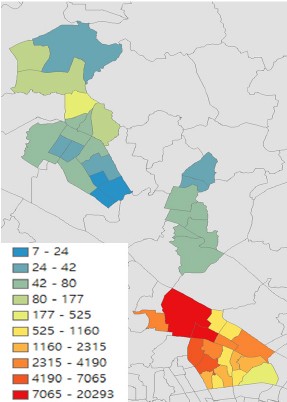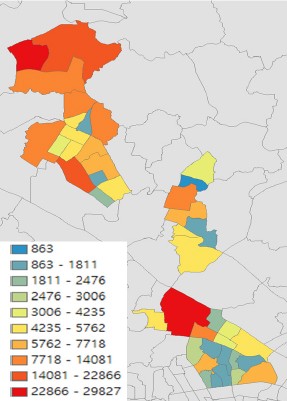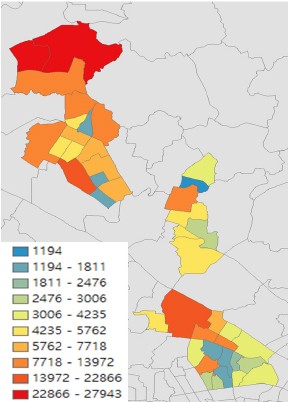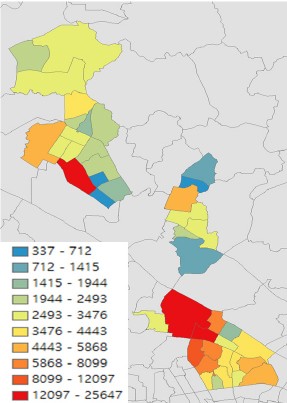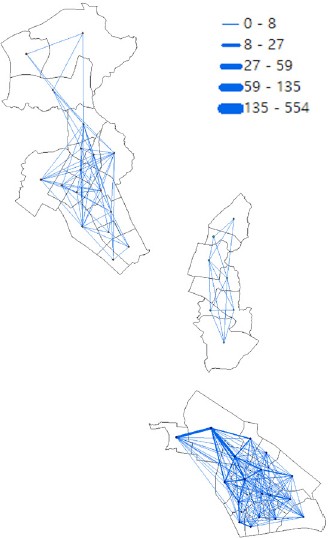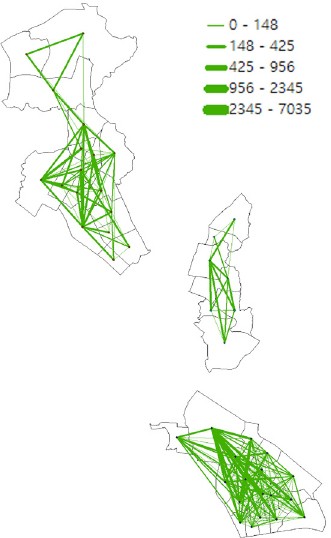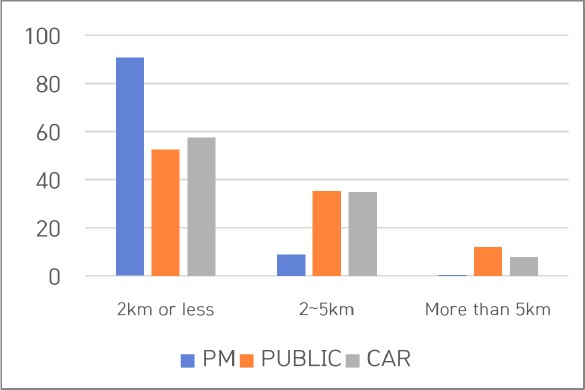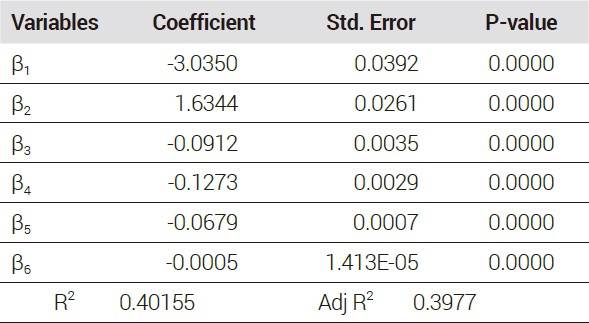
Final publication date 18 Oct 2023
Analysis of the Effect of Travel Cost and Travel Time on the Choice of Personal Mobility Means and a Study on Time Value Estimation
***Bachelor’s Degree, Department of Urban and Regional Development, Mokpo National University lks000112@gmail.com****Assistant Professor, Department of Urban and Regional Development, Mokpo National University sjang@mnu.ac.kr
Abstract
Since personal mobility devices first appeared in Korea in 2012, they have become increasingly widespread. Personal mobility devices are widely used as a means of connecting public transportation nodes with the user’s final destination. Many researchers have analyzed the travel characteristics of personal mobility devices, which differ from those of more traditional means of transportation. However, since existing studies have been conducted based on surveys that ask hypothetical questions, they are not representative of actual travel scenarios. This study is intended to overcome the limitations of existing research by collecting big data created by personal mobility travel and analyzing mode-choice characteristics on this basis. This study defined personal mobility, private cars, and public transportation as mode-choice alternatives. Then, travel time and cost were set as independent variables, and influencing factors were analyzed through multinomial logit analysis. The time value for each mode was calculated based on the calculated coefficient value. The time value of personal mobility was calculated as 10,450 won/hour, that of private cars as 14,423 won/hour, and that of public transportation as 7,742 won/hour. This study is meaningful in that it analyzed the mode-choice characteristics of personal mobility devices based on actual travel data, not survey data under virtual conditions. This study will be used to establish sustainable urban planning practices through a future increase in the mode share of public transportation.
Keywords:
Personal Mobility, Mode Choice, Travel Time Value, Big Data, Multinomial Logit Model키워드:
퍼스널 모빌리티, 수단선택, 통행시간가치, 빅데이터, 다항로짓모형Ⅰ. Research Overview
1. Research Background and Purposes
Today, people travel using various modes of transport, especially private cars and public transportation, such as buses and subways. Yet, most of these transport modes are powered by petroleum or gas. Moreover, with the increased penetration of private cars in recent years, there is a growing concern over the risk of air pollution and environmental degradation. Unlike private cars, however, public transportation still offers advantages. For example, subways are electrically powered, while buses, despite using petroleum or gas as their main fuel, are considered highly efficient as they accommodate a significant number of passengers (Han and Lee, 2004). In this context, various methods for urban and transport planning have been proposed to increase the share of public transportation in passenger traffic. Among these methods, personal mobility (PM) has recently garnered significant attention as an approach to achieving this goal. PM serves as a means to facilitate the mobility of individuals while also functioning as a public transport node.
Simply put, PM refers to compact, low-speed, single-person transport vehicles that are electrically powered. Under the Road Traffic Act PM is defined as personal mobility devices. These vehicles typically operate at around 25 km/h and are easy to use and drive. The use of low-power electric motors and compact batteries makes them highly energy-efficient, resulting in significant savings on fuel costs. With these environmentally friendly advantages, PM has been increasingly at the center of attention as a promising means of transportation (Choi, 2019). The utilization of PM leads to increased connectivity with public transportation, and these vehicles play a critical role in transportation, especially when the travel distance is 1 km or less (for the so-called "last-mile" travel) (Choi and Kim, 2021). PM includes different types of transport vehicles, such as electric bikes, electric wheels, and electric scooters. However, this study specifically focuses on electric scooters.
Electric scooters are costly in terms of initial purchase price and also require storage space and constant maintenance, which makes consumers hesitant to buy them. Against this back drop, on the international front, PM sharing service platforms, such as Lime and Bird, have been put in place. In Korea, since early 2019, PM-sharing services also have been launched, primarily providing services in areas with a large floating population, such as urban areas, school zones, and shopping districts. The industry has been growing in size every year. Additionally, their rental fees are much lower than the cost required to purchase them outright. Thanks to these advantages, PM-sharing services have gained significant attention, leading to a substantial increase in their usage.
In this light, previous studies have primarily focused on the decision-making process of passengers in choosing transportation modes, including PM, and the corresponding changes in utility perceived by passengers. The focus of this study aligns with that of previous research. However, it is worth noting that, in this study, their decision-making process was analyzed based on big data sources derived from the actual usage of PM-sharing services. This approach was taken to address the limitations of previous studies that relied on the findings of surveys conducted under hypothetical conditions. Indeed, this study aimed to analyze the decision-making process of individuals in choosing PM-sharing services based on datasets derived from actual travel data. It also compared the results with those of previous studies, addressing and supplementing their limitations.
2. Flow of Research
The focus of this study is to identify factors that affect the decision-making process of individuals in choosing transportation modes, aiming to enhance connectivity between PM and public transportation (refer to <Figure 1>). To this end, a literature survey was performed, taking into account theoretical considerations by reviewing previous studies on the increased usage of PM, the reasons for their heightened recognition in recent years, factors that affect individuals' transportation mode choice, and time value estimation.
Subsequently, data sets dedicated to the traffic volume, time, and costs for each mode of transportation were collected. The traffic volume of each mode was defined as the dependent variable, while both travel cost and time were set as independent variables. The multinomial logit model was employed to analyze the effect of the independent variables, travel cost and time, on the transportation mode choice of individuals.
Based on the analysis results, the travel time value determined in this study was compared with that provided in the Korea Transport Data Base (KTDB). This approach made it possible to identify factors influencing the transportation mode choice for each means of transport while also estimating the corresponding time values, revealing significant findings.
Ⅱ. Theoretical Considerations and Literature Review
1. Review of Previous Studies on Increased Demand for PM
In Korea, PM devices first appeared in 2012. Their usage has since consistently increased (Jeong, 2022). Previous studies on PM were categorized into two domains. Those in the first category primarily focused on identifying what factors contributed to the increased usage of PM and why such devices had attracted significant attention in recent years. The second-category studies mainly dealt with factors affecting the demand for PM. Initially, factors contributing to the increased usage of PM, along with the reasons for heightened interest in PM devices, were reviewed.
In relation to the increase in the usage of PM devices, the sharing attribute of PM was first examined. Kwon et al. (2021) previously reported that the number of PM-sharing services used in Cheongju-si increased from 195 in September 2020 to 7,168 in March 2021. The study concluded that this increase is attributed to the growing number of people using PM-sharing platforms over time, as well as to PM being the most frequently used means of transportation for short-distance travel. According to Yoo (2019), the expansion of IT platforms and social network services served as catalysts for the growth of sharing economy-driven businesses. Indeed, sharing economy-driven businesses facilitate a close relationship between customers and suppliers, thereby accelerating the growth of PM services. Additionally, the usage of PM influences how people enjoy leisure time and engage in social activities, especially playing a critical role in last-mile travel.
Another factor contributing to the increased usage of PM is that PM devices are primarily used for first- and last-mile travel. Baek et al. (2021) developed and employed a mixed logit model to analyze passengers' preference for a means of transportation when last-mile travel is considered. The study found that PM-sharing services were the most competitive transportation mode when it comes to last-mile travel. Choi and Kim (2021) expected that the use of PM would continue to accelerate over time. The study also argued that PM's contribution to enhancing the quality of last-mile travel services would further grow.
The last factor associated with the increased usage of PM is that PM devices have been increasingly positioned as an eco-friendly means of transportation over time. According to Choi (2019), the sharing attribute of PM devices, as an eco-friendly transportation means, makes them available to more people. The study also explained that the usage of PM, in turn, resulted in a decrease in the use of private cars, therefore reducing exhaust emissions, the primary air pollutants. Furthermore, it argued that this approach would be an effective alternative to address all problems stemming from the increased usage of cars, such as traffic congestion, parking, and air quality issues. The researchers added that PM devices would serve as the primary means of transportation for first- and last-mile travel. Caspi et al. (2020) specified that PM devices were mainly employed for short-distance travel, thereby reducing the use of private cars and, consequently, air pollution. According to Hardt and Bogenberger (2019), PM has recently emerged as a promising means of transportation in European cities. The researchers attributed this trend to the attributes of cars emitting excessive exhaust and noise and requiring large space for parking. Additionally, they noted that PM devices contributed to addressing these issues.
Overall, this part of the literature survey revealed that the usage of PM had significantly grown with the rise of the sharing economy, and PM devices suited the needs for first- and last-mile travel, providing flexible connectivity to public transportation. It was also found that PM devices had received substantial attention, both domestically and internationally, as a promising eco-friendly means of transportation capable of addressing air pollution and environmental issues.
Second, factors influencing the demand for PM were reviewed as follows. Factors that affect the demand for PM include land usage and access to public transportation. Shunhua Bai and Jiao (2020) developed and analyzed a binomial regression model to determine the usage pattern of PM devices in two areas with opposing characteristics. The study revealed that proximity to urban areas, access to public transportation, and diversity in land usage exhibited a positive correlation with the usage of PM. Lee and Jang (2022) comprehensively analyzed the effect of land usage characteristics on the use of PM. In their study, land usage characteristics and access to public transportation were employed as independent variables, while the usage of PM in the morning, afternoon, and evening was respectively designated as a dependent variable for regression analysis. The results showed that land usage patterns had a significant effect on the behavior of PM-sharing service users over time.
In addition to land usage characteristics and access to public transportation, the purpose of travel for PM users and usage time were found to affect the demand for PM. Ahn et al. (2021) investigated the usage characteristics of PM-sharing service users in Seoul. The results showed that these individuals used PM-sharing services for short-distance travel or leisure purposes. It was also found that PM-sharing services served as an auxiliary means of transportation, providing connectivity to public transportation. In a survey on user satisfaction with PM-sharing services, respondents expressed satisfaction with the convenient rental experience and the dockless parking system. Choi and Jang (2022) analyzed the usage patterns of PM-sharing services, thereupon proposing a deployment method for PM devices tailored to each time window. They found that the demand for PM-sharing services, as well as its location, varied depending on the time, and the purpose of using PM-sharing services also differed with the time.
Their literature review on factors influencing the demand for PM services revealed that land usage characteristics and access to public transportation significantly affected the behavior of PM-sharing service users. It was also confirmed that the purpose of using PM varied with the time.
Overall, this study concluded that PM usage substantially increased for various reasons, with an expectation that this trend would continue over time. However, it did not demonstrate what factors affected passengers' choice of PM as a means of transportation. Therefore, previous studies on factors influencing passengers' transportation mode choice were further reviewed to determine what caused them to choose PM.
2. Review of Previous Studies on Factors Affecting Transportation Mode Choice
Previous studies on factors affecting transportation mode choice were categorized into two groups for review: one group focused on passengers' socioeconomic characteristics and the traffic environment and the other group focused on travel cost and time. The first category includes the following studies.
Kim et al. (2020) developed a mode choice model based on the multinomial logit model by analyzing the behavior of 283 Busan metropolitan citizens. As a result, they found that age and gender had a significant effect on their choice of PM devices. They also reported that passengers in their twenties were more likely to prefer PM devices compared to those in other age groups, while female passengers were more likely than their male counterparts to be afraid of trying them. Kim et al. (2021) analyzed the factors impacting the demand factor services using actual performance data from Xingxing Mobility, a PM-sharing service platform. The results indicated that demand was significantly affected by weather conditions and whether it was a weekday or weekend. Usage was lower during weekends or holidays compared to weekdays, and it was substantially reduced during rainy weather. Jo et al. (2021) conducted a survey of 235 Internet cafe users to analyze the usage patterns and characteristics of PM users. The results showed that their jobs, usage location, frequency of use, and driving speed differed depending on the purpose of use. Choi and Jung (2020) conducted a hypothetical survey of 598 citizens aged 20 or older in Busan Metropolitan to determine the factors affecting their intent to use PM-sharing services. The survey outcomes were then analyzed using the ordinal logistic regression model. The results confirmed that the respondents were more likely to prefer PM during clear weather or when an increasing number of bike lanes were allowed to accommodate PM devices.
Overall, the above previous studies confirmed that the choice of PM as a mode of transportation was affected by various factors, including PM users' age, gender, and occupation, as well as whether it was a weekday or weekend or whether PM devices were allowed on bike lanes. More specifically, passengers were more likely to choose PM when they were younger, during weekdays, in clear weather, or when bike lanes were increasingly allowed to accommodate PM devices.
The second category encompasses the following previous studies regarding the effect of travel cost and time on the choice of PM as a means of transportation. Kim et al. (2021) conducted a hypothetical survey of 549 residents in the first and second generation of new towns where PM-sharing services were available. Based on the results, they proposed a mode choice model for PM sharing services, incorporating involved access travel for wide-area transportation and neighborhood travel as parameters. The researchers concluded that the choice of PM-sharing services as a means of transportation was significantly affected by both travel time and cost, not only in neighborhood travel but also in access travel. For access travel, they attributed this to passengers' preference for minimizing travel time. Meanwhile, for neighborhood travel, passengers were more interested in saving costs, and thus the effect of travel cost was the most significant in transportation mode choice. Shim et al. (2020) conducted a hypothetical survey of a total of 549 residents in six of the new towns in the Seoul Metropolitan Area where PM-sharing services were available. The survey was designed to gather information about passengers' intent to choose PM-sharing services as a means of transportation for short-distance neighborhood travel of 5 km or less. Based on the results, a binomial logit model for PM-sharing services was proposed. It was found that the preference for PM-sharing services was lower when the service fees were higher. Lee et al. (2019) also conducted a hypothetical survey to determine passengers' preferences for PM-sharing services and existing transport methods while also analyzing and comparing the corresponding time value, especially in last-mile travel. The results indicated that passengers preferred PM-sharing services in first-mile and last-mile travel necessary for their commute. Passengers were more likely to prefer PM-sharing services when the required walking time was longer. Furthermore, converted time values for each means of transport were estimated using logit analysis, as follows: 387 won/minute for PM sharing services, 423 won/minute for neighborhood buses, and 404 won/minute for walking.
The time value is an index that plays a critical role in predicting traffic demand and evaluating the economic feasibility of transportation investment projects (Ko and Kim, 2020). This time value index has been widely adopted as an important analytical tool to verify the validity of research results in various studies on transportation mode choice in conventional traffic planning (Börjesson and Eliasson, 2014; Chen et al., 2011; and Kim et al., 2017), even before the introduction of PM sharing services.
Börjesson and Eliasson (2014) estimated time values for each means of transportation in Sweden using a logit model and the country's 2008 traffic data. Despite the time value varying depending on the characteristics of given travel and passengers, the researchers estimated time values without considering both attributes and concluded that the time value of private cars was higher than that of buses. Chen et al.(2011) conducted a hypothetical survey of Beijing residents and proposed a logit model to analyze the factors affecting the time value in travel. The results confirmed that the time value was higher in travel for business purposes than in travel for non-business purposes. Kim et al. (2017) employed a multinomial logit model to determine coefficients for travel time and travel cost, thereby estimating the time value in travel. For private cars, the time value was 21,876 won/hour for travel for business purposes and 9,044 won/hour for travel for non-business purposes. For public transport, the time value was 5,016 won/hour for travel for business purposes and 2,638 won/hour for travel for non-business purposes. Overall, the time value for private car users was relatively higher than that for public transport users.
As such, the review of previous studies on the effect of travel cost and time on the choice of PM revealed that both factors played a critical role in passengers' decisions to choose PM devices. It was also found that the time value, as an index, was used in verifying the validity of research results. Among mode choice models, the logit model proved to be the most suitable for that purpose. Both on the domestic and international fronts, the time value of private cars was found to be higher than that of public transport, including buses. Notably, in previous studies, the time value of buses was even higher than that of PM.
The studies on the choice of PM as a means of transportation reviewed in this study were mostly based on data obtained from hypothetical surveys. This approach is advantageous in that researchers can define explanatory variables, and data gathering is easy. However, this process is prone to perception errors, which arise from the inconsistency between behavior and self-awareness.
Dixit et al. (2019) discerned the difference between actual travel data and data drawn from hypothetical surveys and demonstrated how this difference affected the estimation of time value. They concluded that hypothetical surveys were highly likely to result in perception errors, potentially leading to a difference of up to 17% compared to when actual travel data were considered. This paper aimed to overcome the limitations of hypothetical surveys, which are prone to perception errors, by employing actual travel data.
Ⅲ. Research Scope and Differentiation
1. Research Scope
Factors affecting the choice of PM-sharing services were analyzed by defining the following transportation methods: PM devices, private cars, and public transportation. Given that the aim of the present study was to analyze the effect of travel cost and travel time on transportation mode choice, private cars and public transportation, both incurring travel costs, were chosen as alternatives to PM sharing services for comparison.
Data from G-kuter were used as PM usage data, and the spatial scope of the study was set as follows. Three districts were selected for analysis in Seoul and Gyeonggi Province. These areas were chosen due to the high concentration of potential PM users, attributed to the presence of numerous apartment complexes and subway stations, with the aim of collecting as many samples as possible (refer to <Figure 2>). District 1 includes a total of 18 administrative dongs1) in Gangseo-gu and Yangcheon-gu, Seoul. District 2 encompasses a total of six administrative dongs in Deogyang-gu, Goyang-si. District 3 covers a total of 18 administrative dongs in Ilsandong-gu and Ilsanseo-gu, Goyang-si, as well as Paju-si.
The temporal scope of this study was defined as the period from March 29, 2021, to June 27, 2021. The spatial and temporal scopes used for PM data were also applied to the data on private cars and public transportation.
2. Differentiation
Studies on transportation mode choice are typically based on the following two data acquisition methods. The first method involves developing a hypothetical scenario and using it to gauge individuals' preferences of individuals. This approach falls into the category of hypothetical surveys. The other method involves using actual behavioral data drawn from the real actions of individuals rather than developing hypothetical scenarios. Hypothetical surveys are advantageous in that researchers can define explanatory variables and set the degree of variation in them, enabling the collection of effective data when devising a model to predict changes in the behavior of respondents. In addition, data collection is straightforward. However, any preferences perceived are based on hypothetical scenarios, and thus this approach is prone to perception errors, characterized by inconsistency between behavior and self-awareness (Kim, 2006). In contrast, the use of actual behavioral data limits errors in the perception of actions as an objective variable because consistency is ensured. Nonetheless, a challenge lies in the potential for observational errors in its outcomes, and the process of collecting data is rather difficult.
Most previous studies on the choice of PM-sharing services as a means of transportation were primarily based on data drawn from hypothetical surveys. The rationale behind this is the difficulty in acquiring actual data. Consequently, the results of these studies may be highly susceptible to perception errors, which are among the limitations of hypothetical surveys. Against this backdrop, the present study utilized actual travel data drawn from the real actions of individuals. The use of actual travel data reduces the risk of perception errors compared to using data based on hypothetical surveys, differentiating this study from other works.
In general, passenger characteristics are typically analyzed based on disaggregate data, but since the publication of a study by Anas, A. (1981) that employed aggregate data in characterizing passenger patterns, domestic researchers have consistently followed suit (Kang et al., 2017; YU, 2018). Using aggregate data in analyzing passenger characteristics not only reduces data collection time and costs but also lowers the risk of perception errors in SP data. Taking advantage of these benefits, this study analyzed the passenger characteristics of PM-sharing services using aggregate data in this study.
Ⅳ. Analysis Model Development and Data Preparation
1. Analysis Model Development
The logit model is constructed based on random utility theory, which posits that options with greater utility are more likely to be adopted (Bong et al., 2020). The present study employed a multinomial logit model because the number of options available was three. Travel time and travel cost for each means of transportation were defined as independent variables. The selection probability of each option can be expressed as a function as follows.
Numerous previous studies were reviewed before this model was developed. Kim et al. (2020) defined travel time as having different effects on utility depending on the transport mode. However, parameters for travel cost were defined as having the same effect on transportation mode choice. Based on these setups, the researchers drew conclusions. Cho et al. (2017) set different parameters for travel time depending on the purpose of travel, but they applied the same parameters for travel cost regardless of the purpose. Similarly, in this study, parameters were set differently for travel time, while the same parameters were applied for travel cost.
2. Data Preparation
Three types of datasets were prepared, including data on traffic volume, travel time, and travel cost for each transport mode. The data were also categorized into two groups: one for PM devices and the other for other transport modes. Data from G-kuter, a business that accommodates the largest volume of PM usage in Korea, was used as PM data (refer to <Figure 3> and <Figure 4>). The rationale behind this decision is as follows. First, it was necessary to collaborate with a suitable business to acquire the necessary data within a limited research budget. As of March 2021, a total of nine businesses were available in the area of interest (Seoul) to provide PM-sharing services. Among them, G-kuter had the greatest market share. Consequently, the researchers of this study decided to collaborate with G-kuter, with the greatest market share for data acquisition.
To this end, data for about 90 days from March 29, 2021, to June 27, 2021, were collected. The daily traffic volume was then estimated by dividing the total traffic volume by 90 days. Meanwhile, according to Mobile Index, an application analysis service, the share of G-kuter was about 26% in the PM-sharing service market at the time of data acquisition. Therefore, the data provided from G-kuter were adjusted by dividing all values by 0.26, thereby accounting for the traffic volume of other PM-sharing service businesses as well. In this approach, however, it is not clear if the market share of the provider in the area of interest aligns with its total market share. In order to address this issue, the status of PM-sharing service providers was investigated, and the results showed that the top eight PM-sharing service providers with the highest market shares were available to provide services in Seoul, the area of interest. Based on this confirmation, the market share of the provider was employed to adjust the obtained PM traffic data to reflect the total traffic of PM in the area.
The traffic volume data for private cars and public transportation were referenced to the OD data on major transport modes of the Korea Transport DataBase (KTDB) (refer to <Figures 5, 6, 7, and 8>). The OD data on major transport modes are constructed based on the traffic data for all purposes collected during 2019. Among them, specific datasets on private cars and public transportation (buses, subways, and a combination of buses and subways) were considered.
Both travel time data and travel cost data were divided into two groups: one for travel between zones and the other for travel within zones. Here, travel within zones corresponds to any movement occurring within the same administrative dong, while travel between zones refers to any movement from one administration dong to another. The time and cost data for travel between zones were obtained using an algorithm provided by TOVA, a software package developed by OPEN-END. Traffic allocation for private cars was performed based on the Dijkstra algorithm. Following the traffic allocation, the corresponding travel time was estimated. Travel cost was estimated by multiplying the fuel cost for private cars by the average mileage.
Traffic allocation for public transportation was conducted using data on public transportation routes available in the Seoul Metropolitan Area. Using this data, public transportation routes were explored to identify optimal routes and then estimate the corresponding travel time. Travel cost was estimated by considering the integrated transport system based on the distance-based fare plan. The travel time data for public transportation were also divided into two groups: one for travel time within the vehicle and the other for travel time outside the vehicle. The travel time within the vehicle refers to the time during which the passenger actually uses the vehicle, while the travel time outside the vehicle is the time spent for waiting to use the vehicle, for example, transfer time or waiting time.
In this study, a parameter referred to as the total travel time was employed, which was a combination of travel time within the vehicle and travel time outside the vehicle. Transportation modes were categorized into subways, buses, and a combination of subways and buses. Among them, any mode with the shortest travel time was selected and used to determine the cost and time for travel between zones. The interzone network was employed to obtain PM travel time data. First, optimal routes were explored, excluding automobile roads, and these routes were then extracted. For the selected routes, travel time was estimated considering the average travel speed. Travel cost was defined as follows: 100 won per minute of use in addition to 1,000 won for unlocking.
For travel within zones, the travel cost was calculated by estimating the travel distance. It was assumed that each administrative dong was circular, and its radius was defined as the travel distance. The cost and time per distance during travel within zones were then estimated based on the data on travel between zones. The time and cost data for travel within zones were calculated based on the average of the values for travel between zones for each transportation mode. For all PM, private car, and public transportation modes, the time and cost data for travel within zones were obtained by multiplying the travel distance within each zone by both the travel time and travel cost. In this study, the area of interest was divided into three zones, and the data that involved only the travel within each zone were exclusively employed. This implies that traffic data that involve any travel from one of the defined three zones to another are excluded from the analysis.
The configuration of the data obtained for the analysis of transportation mode choice is as follows. First, traffic data were compiled using actual behavioral data on passengers' usage of PM devices, along with the KTDB's OD data on major transport modes. Subsequently, based on these data, any mode with observed traffic volume was defined as the selected transport mode, while the other modes were defined as not being selected. The obtained data were arranged for each existing destination and further integrated with the travel time and cost data for each destination, thereby constituting the transport mode choice data.
Ⅴ. Analysis Results
1. Descriptive Statistics
The descriptive statistics obtained in this study are as follows (refer to <Table 1>). The average traffic volume for travel between zones was 5.1 times for PM, 521.3 times for private cars, and 296.3 times for public transportation, respectively. The corresponding average travel time was 18.3 minutes for PM, 4.8 minutes for private cars, and 30.7 minutes for public transportation, respectively. The average travel cost was 2,731 won for PM, 668 won for private cars, and 1.611 won for public transportation, respectively. The total number of samples used to build a logit model was 382,536. Among them, 2,375 samples were for those who chose PM, while the number of samples for private car travel was 242,399. The number of samples for public transportation travel was 137,762. The total number of traffic zones was 42. The average travel frequency was the highest at 521 times for private cars, while the average time spent was the longest at 31 minutes for public transportation. Finally, PM was found to require the highest travel cost at 2,731 won.
The obtained traffic volume data were schematically illustrated to provide intuitive insight into the travel patterns of each transportation mode in the area of interest. The results confirmed that the traffic volume of PM was relatively high in Gangseo-gu and Yangcheon-gu, Seoul, which were previously defined as District 1. In contrast, the traffic volumes of private cars and public transportation were higher in District 1 and District 3 compared to District 2 (refer to <Figures 9, 10, and 11>).
Given that this study exclusively utilized G-kuter's actual data as PM traffic data, the estimated traffic volume can be affected by the availability of its service. That said, G-kuter's sharing service was fully available across the area of interest for this study, and the data from G-kuter were adjusted considering its market share to represent the total traffic volume in the area. Consequently, it was reasoned that the PM traffic volume data for each district within the area of interest were suitable for use in the analysis of transportation mode choice, along with the traffic volume data for other transport modes. Based on the obtained PM traffic data and KTDB's actual data for private cars and public transportation, the effect of travel time and cost on transportation mode choice was analyzed.
2. Effect of Travel Time and Cost on Transportation Mode Choice
Analysis results were drawn using Limdep 8.0. Before presenting the results, it is worth noting that if the signs of coefficients of the multinomial logit model's parameters are positive, this indicates that the corresponding results are statistically insignificant. This is because positive values of the cost and time parameters can be interpreted as an increase in time and costs and also an increase in utility for the given mode, making the result less meaningful.
The results showed that the values of the time parameters for PM (β3), private cars (β4), and public transportation (β5) were -0.0912, -0.1273, and -0.0679, respectively. The value of the cost parameter (β6) was -0.0005. In private cars, an increase in time resulted in the largest reduction in utility, while in public transportation, the smallest reduction in utility occurred with an increase in time. The reduction in utility for PM fell between the degree observed for the other two modes. The coefficient of determination R2 was 0.40155, while the adjusted coefficient of determination Adj R2 was 0.39765 (refer to <Table 2>).
Meanwhile, if the P-value is 0.05 or less, the corresponding results are interpreted as having statistical significance at a 95% confidence level. In this study, all parameters were found to have a P-value of 0.0000. In addition, the values of the time and cost parameters were all negative, indicating that the corresponding analysis results were statistically significant.
3. Comparison of Travel Time Values
In a study by Kim et al. (2021), short-distance travel was defined as being less than 2 km. For all transportation modes, short-distance travel accounted for the largest portion of traffic. Specifically, travel with a distance of 2-5 km represented about 35% of traffic for private cars and public transportation (refer to <Figure 12>). The travel time value refers to the monetary amount that the passenger is willing to pay to reduce the travel time by a single unit. Simply put, it is a monetary representation of the psychological sense of sacrifice that passengers perceive against unit time when using transportation services. The travel time value was calculated by dividing the time parameter value by the cost parameter value. It was 173 won/minute for PM, 242 won/minute for private cars, and 129 won/minute for public transportation, respectively. When converted to a value per hour, the travel time value was 10,405 won/hour for PM, 14,523 won/hour for private cars, and 7,742 won/hour for public transportation, respectively.
4. Verification of Results Based on KTDB’s Travel Time Value Estimation
According to the time value data for business-purpose travel issued by the KTDB in 2016, the time value was 22,775 won/hour for private cars and 17,260 won/hour for buses. For non-business-purpose travel, it was 9,748 won/hour for private cars and 5,011 won/hour for buses. In addition, the passenger traffic status data issued by the KTDB in 2016 provided information about the proportion of travel for each purpose. Travel for commuting to work accounted for 25.1%, while travel for coming home represented 43.7%. Additionally, travel for other purposes was analyzed as follows: 9.7% for other activities, 7.6% for business purposes, 5.8% for leisure activities, and 4.1% for shopping and going to school. Based on this proportion, the share of travel for commute and travel for non-commute purposes was estimated.
The total travel time value was then estimated by multiplying the time value for business-purpose travel by the proportion of travel for commute and multiplying the time value for non-business-purpose travel by the proportion of travel for non-commute purposes, and adding the two values. The total travel time value was 13,015 won/hour for private cars and 8,082 won/hour for buses.
In the present study, the travel time value was 14,523 won/hour for private cars and 7,742 won/hour for public transportation. When compared to the data provided by the KTDB in 2016, the discrepancy was about 11.5% for private cars and about 4.3% for public transportation, indicating that the two sets of results were quite comparable (refer to <Table 3>).
In addition, the time value of PM-sharing services estimated in this study was higher than that of public transportation. In order to verify the validity of this analysis, the current results were compared with previous studies. According to Pourhashem et al. (2023), the time value of PM-sharing services is about 1.85 times larger than that of public transportation. In this study, the time value of PM-sharing services was about 1.34 times greater compared to public transportation. This comparison confirms that the findings of the present study align with those presented by the previous study, despite that it is not possible to demonstrate how accurate the time value estimated in this study would be. Based on these results and verification efforts, it is reasoned that the time value for PM estimated in this study, i.e., 10,405 won/hour, has sufficient statistical significance.
VI. Conclusions
Recently, the usage of PM has significantly increased in Korea. In line with this trend, the concept of eco-city has been increasingly at the center of attention, leading to a growing emphasis on sustainable urban planning. This study aimed to identify factors affecting the decision-making process of PM-sharing service users for mode choice. To this end, factors influencing the choice of PM as a transportation mode were identified and analyzed. The two major findings of the present study are as follows.
First, the time value for PM was estimated based on big data on actual traffic. In fact, many studies on transportation mode choice and travel time value estimation have employed actual traffic data. However, the subjects of interest in these studies are mostly limited to private cars and public transportation. Thus, it is worth noting that this study employed actual traffic data to analyze passengers' preference for PM and estimate the corresponding travel time value. This clearly differentiates this study from previous works. The values of parameters for each transportation mode are as follows. The value of the time parameter was -0.0912 for PM, -0.1273 for private cars, and -0.0679 for public transportation, respectively. The value of the cost parameter was -0.0005.
In private cars, an increase in time resulted in the largest reduction in utility, while in public transportation, the smallest reduction in utility occurred with an increase in time. The reduction in utility for PM fell between the degree observed for the other two modes. The time value was 10,405 won/hour for PM, 14,523 won/hour for private cars, and 7,742 won/hour for public transformation, respectively. To the best of our knowledge, no studies have so far focused on the choice of PM as a transportation mode and travel time value estimation based on actual traffic data, although some have conducted research on estimating time value for private cars and public transportation. This attempt was made for the first time in this study, adding great significance to the research.
Second, this study highlighted the limitations of estimating the time value for PM based on data obtained from hypothetical surveys. Most previous studies on time value estimation for PM were primarily based on hypothetical surveys. However, it was found that there was a substantial discrepancy between the two sets of results obtained based on hypothetical surveys and actual traffic big data. According to the data provided by the KTDB in 2016, the travel time value was 13,015 won/hour for private cars and 8,082 won/hour for buses. Meanwhile, the travel time value estimated in this study was 14,523 won/hour for private cars and 7,742 won/hour for buses. When compared to the KTDB's data, the discrepancy was about 11.5% for private cars and about 4.3% for public transportation. In a study by Lee et al. (2019), the time value estimated based on a hypothetical survey was 387 won/minute for PM and 423 won/minute for neighborhood buses. When converted to a value per hour, the time value was 23,220 won/hour for PM and 25,380 won/hour for neighborhood buses.
Overall, the time values estimated based on hypothetical surveys were higher compared to those estimated in this study. Moreover, the previous study reported that the time value of neighborhood buses was higher than that of PM. However, in this study, the time value was higher fpr PM than for neighborhood buses. When compared to the time value data provided by the KTDB, the results estimated based on hypothetical surveys exhibited a difference of about 69%, which was much larger than the value of 4.3% found in this study. As such, it was confirmed that there was substantial inconsistency between the two sets of results obtained based on hypothetical surveys and actual traffic big data. Based on this conclusion, it was reasoned that the major findings of the present study, including mode choice results and travel time value estimation, were more reliable compared to those presented in previous studies.
However, this study has limitations in that only travel cost and time were defined and used as factors affecting transportation mode choice, excluding walking as an alternative mode. Additionally, only short-distance travel was considered for analysis. Future studies will focus on expanding the scope of parameters to include age, gender, and other attributes while also including walking as an alternative transport mode and taking into account analysis models for long-distance travel as well. Another limitation is that due to the difficulty in collecting data, only the PM data provided by a certain service provider in the area of interest were considered, and the total traffic volume was obtained by adjusting the data based on the provider's market share. This limitation will be addressed in future studies by gaining access to the total traffic data of all PM-sharing services available in the area of interest.
Acknowledgments
This research was funded and supported by the Basic Research Project in Science and Engineering of the National Research Foundation of Korea under the Ministry of Education and the Land, Infrastructure and Transport Technology Promotion Project of the Korea Agency for Infrastructure Technology Advancement under the Ministry of Land, Infrastructure and Transport (NRF-2020R1I1A1A01067265) (RS-2021-KA164289).
This paper was prepared by correcting and supplementing part of a paper presented at the 2022 Fall Conference of the Korea Planning Association.
References
-
Ahn, D.E., Lee, K.H., and Ko, E.J., 2021. “Analysis of Factors influencing the Satisfaction of Use Environment of Shared Electric Kickboard – The Case of Seoul, South Korea –”, Journal of the Architectural Institute of Korea, 37(7): 3-11.
안다은·이경환·고은정, 2021. “공유 전동킥보드 이용환경만족도 영향요인 분석 –서울시를 대상으로–”, 「대한건축학회논문집」, 37(7): 3-11. -
Anas, A., 1981. “The Estimation of Multinomial Logit Models of Joint Location and Travel Mode Choice from Aggregated Data”, Journal of Regional Science, 21: 223-242.
[https://doi.org/10.1111/j.1467-9787.1981.tb00696.x]

-
Baek, K.H., Lee, H.S., Chung, J.H., and Kim, J.H., 2021. “Electric Scooter Sharing: How Do People Value It As a Last-mile Transportation Mode?”, Transportation Research Part D: Transport and Environment, 90.
[
https://doi.org/10.1016/j.trd.2020.102642
]

백광호·이혁성·정진혁·김진희, 2021. “Electric Scooter Sharing: How Do People Value It As a Last-mile Transportation Mode?”, Transportation Research Part D: Transport and Environment 90. -
Bai, S. and Jiao, J., 2020. “Dockless E-Scooter Usage Patterns and Urban Built Environments: A Comparison Study of Austin, TX, and Minneapolis MN”, Travel Behaviour and Society, 20: 264-272.
[https://doi.org/10.1016/j.tbs.2020.04.005]

-
Bong, K.H., Kim, S.M., and Park, J.M., 2020. “A Study on the Determinants of Innovation Investment in Small and Medium-sized Enterprises Using Multinomial Logit Model”, Journal of Korea Technology Innovation Society, 23(1): 140-161.
[
https://doi.org/10.35978/jktis.2020.2.23.1.140
]

봉강호·김수민·박재민, 2020. “다 항로짓모형을 활용한 중소기업의 혁신투자 결정요인 연구”, 「기술혁신학회지」 23(1): 140-161. -
Börjesson, M. and Eliasson, J., 2014. “Experiences from the Swedish Value of Time Study”, Transportation Research Part A : Policy and Practice, 59: 144-158.
[https://doi.org/10.1016/j.tra.2013.10.022]

-
Caspi O., Smart, M.J., and Noland, R.B., 2020. “Spatial Associations of Dockless Shared E-scooter Usage”, Transportation Research Part D: Transport and Environment, 86: 1-15.
[https://doi.org/10.1016/j.trd.2020.102396]

-
Chen X., Liu, Q., and Du, G., 2011. “Estimation of Travel Time Values for Urban Public Transport Passengers Based on SP Survey”, Jeurnal of Transportation Systems Engineering and Information Technology, 11(4): 77-84.
[https://doi.org/10.1016/S1570-6672(10)60132-8]

-
Cho, S.H., S, Y.H., Kho, S.Y., and Rhee, S.M., 2017. “Estimation of Interregional Mode Choice Models and Value of Travel Time Accommodating Taste Variation of Individuals”, Journal of the Korean Society for Railway, 20(2): 288-298.
[
https://doi.org/10.7782/JKSR.2017.20.2.288
]

조신형·서영현·고승영·이성모, 2017. “개인의 선호다양성을 고려한 지역간 수단선택 모형 구축 및 시간가치 추정 연구”, 「한국철도학회 논문집」, 20(2): 288-298. -
Choi, H.J. and Jang, S.M., 2022. “A Study on the Demand-Driven Layout Method of Shared Personal Mobility to Increase Public Transportation Utilization”, Journal of the Korean Cadastre Information Association, 24(1): 126-137.
[
https://doi.org/10.46416/JKCIA.2022.04.24.1.126
]

최혜정·장성만, 2022. “대중교통 이용률을 높이기 위한 공유 전동킥보드의 수요 주도형 배분 방법 연구”, 「한국지적정보학회지」, 24(1): 126-137. -
Choi, M.H. and Jung, H.Y., 2020. “A Study on the Influencing Factor of Intention to Use Personal Mobility Sharing Services”, Journal of Korean Society of Transportation, 38(1): 1-13.
[
https://doi.org/10.7470/jkst.2020.38.1.001
]

최민혜·정헌영, 2020. “Personal Mobility 공유서비스 이용의향에 미치는 영향요인에 관한 연구”, 「대한교통학회지」, 38(1): 1-13. -
Choi, M.J., 2019. “A Study of on the Public Sharing Foundation of Personal Mobility”, Master’s Degree Dissertation, Donga University
최민정, 2019. “퍼스널 모빌리티(Personal Mobility, PM)의 공공 쉐어링 시스템 디자인에 대한 사례연구”, 동아대학교 석사학위논문. -
Choi, N.H. and Kim, J.H., 2021. “A Comparative Study on the Perceptions towards Personal Mobility Vehicle between Adults and Minors”, KSCE Journal of Civil And Environmental Engineering Research, 41(5): 543-550.
최낙현·김정화, 2021. “개인형 이동수단에 관한 법·제도 개선방안 연구: 연령별 차이를 중심으로”, 「대한토목학회논문집」, 41(5): 543-550. -
Dixit V., Jian, S., Hassan, A., and Robson, E.N., 2019. “Eliciting Perceptions of Travel Time Risk and Exploring Its Impact on Value of Time”, Transport Policy, 82: 36-45.
[https://doi.org/10.1016/j.tranpol.2019.08.001]

-
Han, J.H., and Lee, S.J., 2004, “Reviews of Urban Bus Transit Network Design Methodology”, Paper presented at the KOR-KST Conference, Gyeongsan: Yeungnam University, 1-6.
한종학·이승재, 2004. “시내버스 노선망 설계방법론 고찰”, 대한교통학회 제46회 학술발표회, 경산: 영남대학교, 1-6. -
Hardt, C. and Bogenberger, K., 2019. “Usage of E-Scooters in Urban Environments”, Transportation Research Procedia 37: 155-162.
[https://doi.org/10.1016/j.trpro.2018.12.178]

-
Jo, H.H., Noh, H.S., Yoo, H.C., Kang, J.E., Jung J.E., and Kim H.S., 2021. “A Study on the Use Behavior and Safety of Electric Scooters – Focused on the Survey of E-Scooter Owners –”, The Geographical Journal of Korea, 55(1): 43-55.
[
https://doi.org/10.22905/kaopqj.2021.55.1.4
]

조항훈·노한승·유호찬·강지은·정지은·김흥순, 2021. “전동킥보드 이용행태 및 안전에 관한 연구 –전동킥보드 소유자에 대한 설문을 중심으로–”, 「국토지리학회지」, 55(1): 43-55. -
Kang, W., Lee, J.H., and Park, M.C., 2017. “Freight Mode Choice Modelling with Aggregate RP Data and Disaggregate SP Data”, Journal of the Korea Society for Railway, 20(2): 265-274.
[
https://doi.org/10.7782/JKSR.2017.20.2.265
]

강웅·이장호·박민철, 2017. “집계적 현시선호자료와 비집계적 진술선호자료를 이용한 화물수단선택모형 구축”, 「한국철도학회 논문집」, 20(2): 265-274. -
Kim, G.S., 2006. “SP Survey Design and Analysis Methodology – Preference Survey for Hypothetical Situations”, Planning and Policy, 296: 110-121.
김강수, 2006. “SP조사 설계 및 분석방법론 – 가상의 상황에 대한 선호도 조사”, 「국토」 296: 110-121. -
Kim, J.H., Kim, I.K., and Yoo, H.S., 2020. “Mode Choice Model of New Travel Mode about FLM with Latent Variables”, Paper presented at the KOR-KST Conference, Korean Society of Transportation Secretariat(On-Line), 25.
김지혜·김익기·유한솔, 2020. “잠재변수를 고려한 신교통수단의 FLM 수단선택모형에 관한 연구”, 대한교통학회 제82회 학술발표회, 대한교통학회 사무국(온라인), 25. -
Kim, J.H., Kim, I.K., and Yoo, H.S., 2021. “Choice Behavior Analysis for Feeder Modes on First and Last Mile with Qualitative Factors”, Journal of Korean Society of Transportation, 39(1): 14-29.
[
https://doi.org/10.7470/jkst.2021.39.1.014
]

김지혜·김익기·유한솔, 2021. “정성적 요인을 반영한 초단거리 접근수단의 선택 행태연구”, 「대한교통학회지」, 39(1): 14-29. -
Kim, J.Y., Kim, S.J., Lee, G.J., and Choo, S.H., 2021. “Estimating a Mode Choice Model Considering Shared E-scooter Service –Focused on Access Travel and Neighborhood Travel–”, The Journal of the Korea Institute of Intelligent Transport Systems, 20(1): 22-39.
[
https://doi.org/10.12815/kits.2021.20.1.22
]

김지윤·김수재·이경재·추상호, 2021. “공유 전동킥보드를 고려한 수단선택모형 추정 –접근통행과 생활권통행을 중심으로–”, 「한국ITS학회논문지」, 20(1): 22-39. -
Kim, K.H., Lee, J.H., and Yun, I.S., 2017. “Calculation of Travel Time Values in Seoul Metropolitan Area Considering Unique Travel Patterns”, Journal of Korean Society of Transportation, 35(6): 481-498.
[
https://doi.org/10.7470/jkst.2017.35.6.481
]

김경현·이장호·윤일수, 2017. “수도권 통행 특성을 고려한 통행시간가치 산정 연구”, 「대한교통학회지」, 35(6): 481-498. -
Kim, S.J., Lee, G.J., Choo, S.H., and Kim, S.H., 2021. “Study on Shared E-scooter Usage Characteristics and Influencing Factors”, The Journal of the Korea Institute of Intelligent Transport Systems, 20(1): 40-53.
[
https://doi.org/10.12815/kits.2021.20.1.40
]

김수재·이경재·추상호·김상훈, 2021. “공유 전동킥보드 이용 특성 및 영향요인에 관한 연구”, 「한국ITS학회논문지」, 20(1): 40-53. -
Ko, Y.S. and Kim S.R., 2020, “Developing and Utilizing Flexible Travel Time Values to Strengthen the Public Nature of Roads ”, KRIHS Policy Brief, 1-6.
고용석·김상록, 2020, “도로 공공성 강화를 위한 유연한 통행시간가치 개발 및 활용 방안”, 「국토정책 Brief」, 1-6. -
Kwon, S.I., Kim, N.Y., Kim, S.H., Jung, Y.I., Lee, Y.M., and Song, T.J., 2021. “An Win-Win Strategy of Personal Mobility Service in Cheongju”, Transportation Technology and policy, 18(4): 7-13.
권순일·김나연·김상훈·정용일·이영민·송태진, 2021. “개인형 이동장치 서비스 상생형 발전 방향: 청주시를 대상으로”, 「교통기술과 정책」, 18(4): 7-13. -
Lee, H.S., Baek, K.H., Jung, J.H., and Kim, J.H., 2019. “User’s Behaviors of Smart Personal Mobility Sharing Services: Emperical Evidence from Electric Scooter Sharing Service”, Paper presented at the KOR-KST Conference, Yeosu Expo Convention Center, 462-463.
이혁성·백광호·정진혁·김진희, 2019. “스마트 퍼스널 모빌리티 공유 서비스 이용자 특성에 관한 연구: 전동킥보드 공유 서비스를 예시로”, 대한교통학회 제81회 학술발표회, 여수엑스포컨벤션센터, 462-463. -
Lee, J.W. and Jang, S.M., 2022. “An Effect of Land Use Characteristics and Policy Changes on Shared Personal Mobility Use”, Journal of Korea Planning Association, 57(2): 153-167.
[
https://doi.org/10.17208/jkpa.2022.04.57.2.153
]

이재욱·장성만, 2022. “토지이용 특성과 정책의 변화가 공유 퍼스널 모빌리티 이용에 미치는 영향”, 「국토계획」, 57(2): 153-167. -
Pourhashem, G., Georgouli, C., Malichová E., Straka, M., and Kováčiková, T., 2023. “Factors Influencing the Perceived Value of Travel Time in European Urban Areas”, Transportation, 1-21.
[https://doi.org/10.1007/s11116-023-10376-2]

-
Shim, S.B., Kim J.Y., Shim, J.H., and Choo, S.H., 2020. “Analyzing Factors to Influence Choice of E-scooter”, Paper presented at the KOR-KST Conference, Gangneung: St. John’s Hotel, 448-449.
심수빈·김지윤·심지현·추상호, 2020. “개인형 이동수단 공유 서비스 선택 영향요인 분석”, 대한교통학회 제83회 학술발표회, 강릉: 세인트존스호텔, 448-449. -
Yoo, S.Y., 2019. “A Study on the Factors Affecting the Intention to Use of Personal Mobility Services Based on the Sharing Economy Platform”, Master’s Degree Dissertation Soongsil University.
유순영, 2019. “공유경제 플랫폼 기반의 퍼스널 모빌리티 서비스 이용 의도에 영향을 미치는 요인에 관한 연구”, 숭실대학교 석사학위논문. -
YU, J.W., 2018. “Outbound Air Travelers’ Airport Choice Model Using Aggregate Observation Data”, Journal of Korean Society of Transportation, 36(5): 392-401.
[
https://doi.org/10.7470/jkst.2018.36.5.392
]

유정훈, 2018. “집계 관측 자료를 이용한 국제선 여객 공항선택 모형”, 「대한교통학회지」, 36(5): 392-401. -
Jung, W.T., 2022. 3. 10. “Creating a Personal Mobility (PM) Industrial Ecosystem... Construction of a Demonstration Support Center in Seongseo Industrial Complex”, Yeongnamilbo, https://www.yeongnam.com/web/view.php?key=20220309010001410, .
정우태, 2022. 3. 10. “PM(퍼스널 모빌리티)산업 생태계 조성... 성서산단 내 실증지원센터 구축”, 영남일보, https://www.yeongnam.com/web/view.php?key=20220309010001410, .


